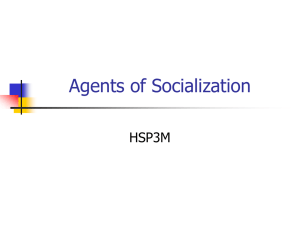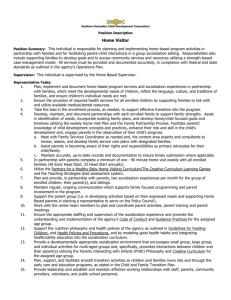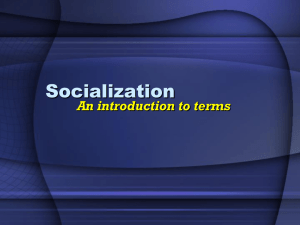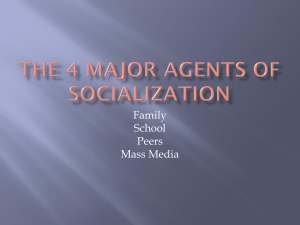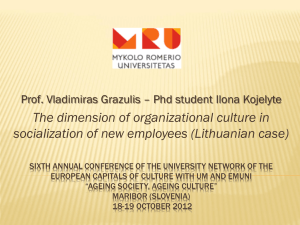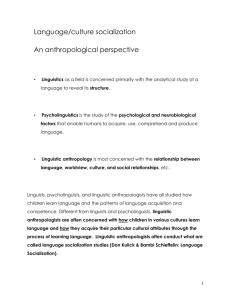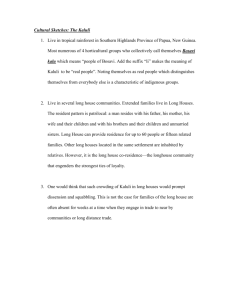Language socialization paradigm power point
advertisement
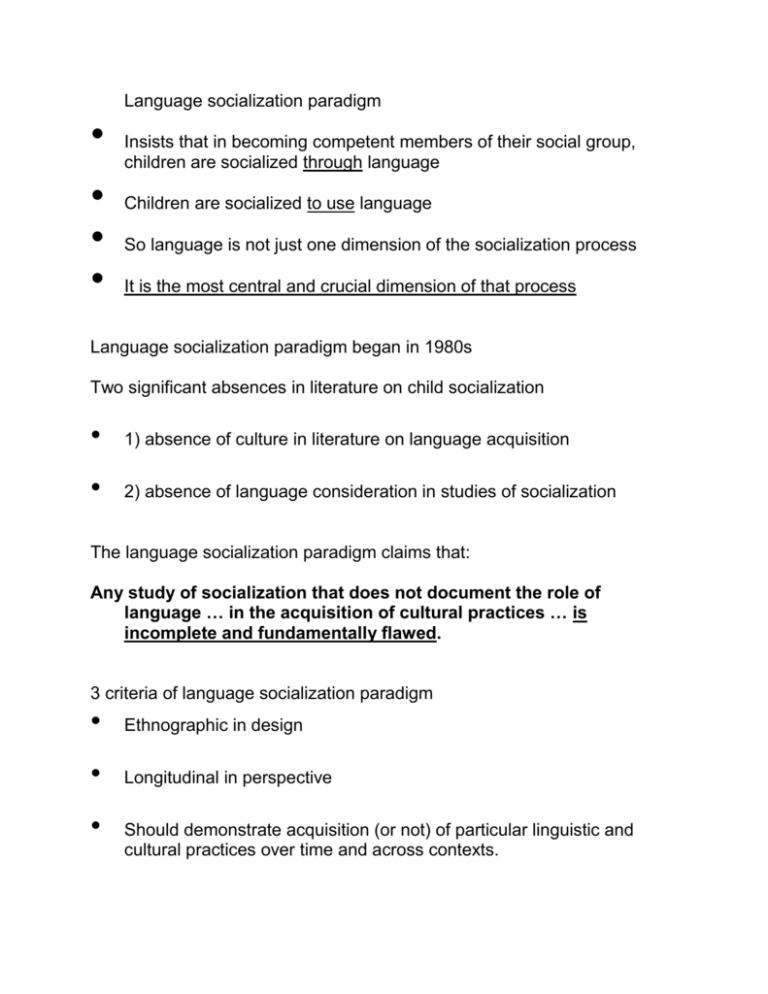
Language socialization paradigm • • • • Insists that in becoming competent members of their social group, children are socialized through language Children are socialized to use language So language is not just one dimension of the socialization process It is the most central and crucial dimension of that process Language socialization paradigm began in 1980s Two significant absences in literature on child socialization • 1) absence of culture in literature on language acquisition • 2) absence of language consideration in studies of socialization The language socialization paradigm claims that: Any study of socialization that does not document the role of language … in the acquisition of cultural practices … is incomplete and fundamentally flawed. 3 criteria of language socialization paradigm • Ethnographic in design • Longitudinal in perspective • Should demonstrate acquisition (or not) of particular linguistic and cultural practices over time and across contexts. Past studies assumed that cultural competence was complete after adolescence Language studies emphasize the socializing nature of all human interaction. Multiple agencies are present and should be accounted for in any social interaction Mother child interactions • • It is not only the child who is being socialized The child, through her/his actions and verbalizations, is also actively socializing the mother as a mother Co-workers socialize each other as co-workers Lovers socialize each other as lovers Setting up the background for studies that demonstrate how different kinds of culturally intelligible subjectivities come into being. Affective stance • • Affect – experience of feeling an emotion Stance – expressing feeling and emotion “The ability to display culturally intelligent affective stances is crucial to being a recognizable subject in any social group.” (Hymes 1974) In other words, different cultural contexts require that people display and express their feelings and emotions in certain ways. In addition, people in different cultural contexts will interpret what they see or hear according to culturally understood affective stances. Cultural conventions for displaying, invoking, and interpreting affect • Laughing, crying, saying you’re sorry … these are examples of “doing an emotion” (affect stance) Affective stances are attributed to infants early on This attribution influences how caretakers respond and react to infants … and because parents are part of a system of shared cultural know-how and assumptions, they will attribute emotions to infants based on those cultural assumptions. … which influences how children come to act and speak and how they learn to be part of their own culture groups • http://www.youtube.com/watch?v=FDDGy3-7nyU&NR=1 Gapun, Papua New Guinea Linguistic anthropologist Don Kulick • Caregivers typically assume that the affective stance of infant displays dissatisfaction and anger Assume infants are naturally stubborn, willful, big headed • • • • • “A child cooing softly in its mother’s lap is likely to be shaken suddenly and asked ‘Ai! What are you mad about!’ The first words attributed to a baby are oki, mnda and ayata – words which mean ‘I’m leaving’, ‘I’m sick of this’ and ‘Stop it’, respectively. Imputed aggression in babies is matched by those tending them. Common face play with babies involves the caregiver biting lower lip, widening eyes, thrusting out chin sharply, raising heal of hand in threatening manner, swinging it within inches of the child’s face and then pulling it back. Then the caregiver laughs at the baby and nuzzles her/him. Anger is a structuring principle of social life in the village. Anger is dangerous so it is important to learn how to avoid making others angry. It is also important to work on controlling anger. In relations between men and women • Women are held to be selfish and always ready to vent anger. • Men are expected to suppress their anger for the greater social good. Making someone angry can cause the one who is angered, ancestors, and/or supernatural to cause sickness and death for the one who caused anger. Kaluli, Papua New Guinea • • • • • Adults assume that infants are ‘soft’ or helpless, vulnerable, and without understanding. The first sounds produced by children that are recognized by adults as Kaluli words are no: and bo, ‘mother’ and ‘breast’. “Attest s to a social view of language expressing the child’s primary relationship and the giving of food that is central to its constitution.” Kaluli say that children know how to beg and whine to get what they want, but they must be taught to use language. Kaluli use no baby talk or simplified speech when communicating with their infants. Instead, they socialize young children by telling them precisely what to say and how to say it. Caregivers see themselves as helping infants to develop hardness • Children need to acquire assertive demeanors, which they lack • • • Mothers often tell their babies to ‘say it’ to get them to request, command, tease, and challenge They model what they want the child to say and how it should be said. They may talk for the child when she/he is an infant – facing the child outward and moving his/her arms etc. The idea is that in the Kaluli “egalitarian” economic situation … • • Children must learn to get what they need and want in appropriate ways … To be assertive at the right times …


